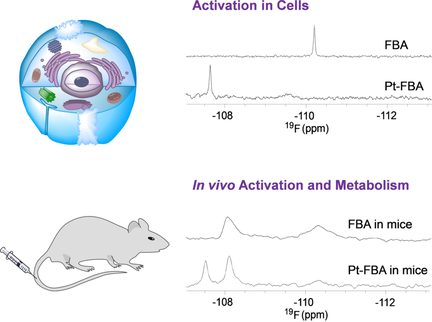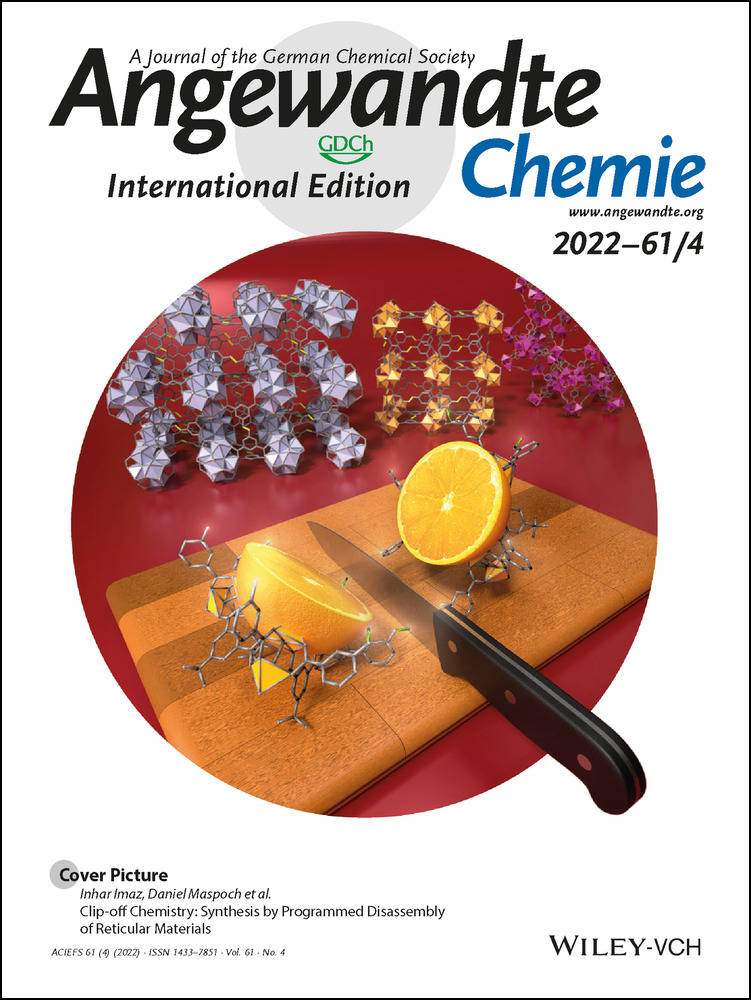19F NMR Allows the Investigation of the Fate of Platinum(IV) Prodrugs in Physiological Conditions
Dr. Siming Yuan
Department of Pharmacy, the First Affiliated Hospital of USTC, Division of Life Sciences and Medicine, Department of Chemistry, University of Science and Technology of China, Hefei, Anhui, China
Search for more papers by this authorDr. Yang Zhu
Department of Pharmacy, the First Affiliated Hospital of USTC, Division of Life Sciences and Medicine, Department of Chemistry, University of Science and Technology of China, Hefei, Anhui, China
Search for more papers by this authorDr. Yi Dai
Department of Pharmacy, the First Affiliated Hospital of USTC, Division of Life Sciences and Medicine, Department of Chemistry, University of Science and Technology of China, Hefei, Anhui, China
Search for more papers by this authorYu Wang
Department of Pharmacy, the First Affiliated Hospital of USTC, Division of Life Sciences and Medicine, Department of Chemistry, University of Science and Technology of China, Hefei, Anhui, China
Search for more papers by this authorDuo Jin
Department of Pharmacy, the First Affiliated Hospital of USTC, Division of Life Sciences and Medicine, Department of Chemistry, University of Science and Technology of China, Hefei, Anhui, China
Search for more papers by this authorManman Liu
Department of Pharmacy, the First Affiliated Hospital of USTC, Division of Life Sciences and Medicine, Department of Chemistry, University of Science and Technology of China, Hefei, Anhui, China
Search for more papers by this authorCorresponding Author
Prof. Liqin Tang
Department of Pharmacy, the First Affiliated Hospital of USTC, Division of Life Sciences and Medicine, Department of Chemistry, University of Science and Technology of China, Hefei, Anhui, China
Search for more papers by this authorProf. Fabio Arnesano
Dipartimento di Chimica, Università di Bari “A. Moro”, via E. Orabona 4, 70125 Bari, Italy
Search for more papers by this authorCorresponding Author
Prof. Giovanni Natile
Dipartimento di Chimica, Università di Bari “A. Moro”, via E. Orabona 4, 70125 Bari, Italy
Search for more papers by this authorCorresponding Author
Prof. Yangzhong Liu
Department of Pharmacy, the First Affiliated Hospital of USTC, Division of Life Sciences and Medicine, Department of Chemistry, University of Science and Technology of China, Hefei, Anhui, China
Search for more papers by this authorDr. Siming Yuan
Department of Pharmacy, the First Affiliated Hospital of USTC, Division of Life Sciences and Medicine, Department of Chemistry, University of Science and Technology of China, Hefei, Anhui, China
Search for more papers by this authorDr. Yang Zhu
Department of Pharmacy, the First Affiliated Hospital of USTC, Division of Life Sciences and Medicine, Department of Chemistry, University of Science and Technology of China, Hefei, Anhui, China
Search for more papers by this authorDr. Yi Dai
Department of Pharmacy, the First Affiliated Hospital of USTC, Division of Life Sciences and Medicine, Department of Chemistry, University of Science and Technology of China, Hefei, Anhui, China
Search for more papers by this authorYu Wang
Department of Pharmacy, the First Affiliated Hospital of USTC, Division of Life Sciences and Medicine, Department of Chemistry, University of Science and Technology of China, Hefei, Anhui, China
Search for more papers by this authorDuo Jin
Department of Pharmacy, the First Affiliated Hospital of USTC, Division of Life Sciences and Medicine, Department of Chemistry, University of Science and Technology of China, Hefei, Anhui, China
Search for more papers by this authorManman Liu
Department of Pharmacy, the First Affiliated Hospital of USTC, Division of Life Sciences and Medicine, Department of Chemistry, University of Science and Technology of China, Hefei, Anhui, China
Search for more papers by this authorCorresponding Author
Prof. Liqin Tang
Department of Pharmacy, the First Affiliated Hospital of USTC, Division of Life Sciences and Medicine, Department of Chemistry, University of Science and Technology of China, Hefei, Anhui, China
Search for more papers by this authorProf. Fabio Arnesano
Dipartimento di Chimica, Università di Bari “A. Moro”, via E. Orabona 4, 70125 Bari, Italy
Search for more papers by this authorCorresponding Author
Prof. Giovanni Natile
Dipartimento di Chimica, Università di Bari “A. Moro”, via E. Orabona 4, 70125 Bari, Italy
Search for more papers by this authorCorresponding Author
Prof. Yangzhong Liu
Department of Pharmacy, the First Affiliated Hospital of USTC, Division of Life Sciences and Medicine, Department of Chemistry, University of Science and Technology of China, Hefei, Anhui, China
Search for more papers by this authorGraphical Abstract
Abstract
PtIV prodrugs can overcome resistance and side effects of conventional PtII anticancer therapies. By 19F-labeling of a PtIV prodrug (Pt-FBA, FBA=p-fluorobenzoate), the activation under physiological conditions could be investigated. Unlike single-electron reductants, multi-electron agents can efficiently promote the two electrons reduction of PtIV to PtII. The activation of Pt-FBA in cell lysate is highly dependent upon the type of cancer cells. When administered to E. coli, Pt-FBA is reduced intracellularly and free FBA can shuttle out of the cell. The reduction rate greatly increases by inducing metallothionein overexpression and is lowered by addition of ZnII ions. When injected into mice, Pt-FBA undergoes fast reduction in the bloodstream accompanied by metabolic degradation of FBA; nevertheless, unreduced Pt-FBA can accumulate to detectable levels in liver and kidneys. The 19F NMR approach has the advantage of avoiding the interference of all background signals.
Conflict of interest
The authors declare no conflict of interest.
Supporting Information
As a service to our authors and readers, this journal provides supporting information supplied by the authors. Such materials are peer reviewed and may be re-organized for online delivery, but are not copy-edited or typeset. Technical support issues arising from supporting information (other than missing files) should be addressed to the authors.
| Filename | Description |
|---|---|
| anie202114250-sup-0001-misc_information.pdf2.2 MB | Supporting Information |
Please note: The publisher is not responsible for the content or functionality of any supporting information supplied by the authors. Any queries (other than missing content) should be directed to the corresponding author for the article.
References
- 1
- 1aT. C. Johnstone, K. Suntharalingam, S. J. Lippard, Chem. Rev. 2016, 116, 3436–3486;
- 1bC. Jia, G. B. Deacon, Y. Zhang, C. Gao, Coord. Chem. Rev. 2021, 429, 213640;
- 1cX. Hu, F. Li, N. Noor, D. Ling, Sci. Bull. 2017, 62, 589–596;
- 1dD. Gibson, Dalton Trans. 2016, 45, 12983–12991;
- 1eD. Gibson, J. Inorg. Biochem. 2021, 217, 111353;
- 1fS. van Zutphen, J. Reedijk, Coord. Chem. Rev. 2005, 249, 2845–2853;
- 1gE. J. Anthony, E. M. Bolitho, H. E. Bridgewater, O. W. L. Carter, J. M. Donnelly, C. Imberti, E. C. Lant, F. Lermyte, R. J. Needham, M. Palau, P. J. Sadler, H. Shi, F. Wang, W. Zhang, Z. Zhang, Chem. Sci. 2020, 11, 12888–12917.
- 2
- 2aA. O. Sartor, D. P. Petrylak, J. A. Witjes, W. R. Berry, G. S. Chatta, D. J. Vaughn, J. Ferrero, T. Demkow, J. C. Eymard, C. N. Sternberg, J. Clin. Oncol. 2008, 26 (15_suppl), 5003–5003;
- 2bH. Choy, C. Park, M. Yao, Clin. Cancer Res. 2008, 14, 1633–1638.
- 3
- 3aZ. Wang, Z. Deng, G. Zhu, Dalton Trans. 2019, 48, 2536–2544;
- 3bH. Y. Shi, C. Imberti, P. J. Sadler, Inorg. Chem. Front. 2019, 6, 1623–1638.
- 4C. Loup, A. T. Vallina, Y. Coppel, U. Letinois, Y. Nakabayashi, B. Meunier, B. Lippert, G. Pratviel, Chem. Eur. J. 2010, 16, 11420–11431.
- 5
- 5aM. D. Hall, C. T. Dillon, M. Zhang, P. Beale, Z. Cai, B. Lai, A. P. J. Stampfl, T. W. Hambley, J. Biol. Inorg. Chem. 2003, 8, 726–732;
- 5bR. A. Alderden, H. R. Mellor, S. Modok, M. D. Hall, S. R. Sutton, M. G. Newville, R. Callaghan, T. W. Hambley, J. Am. Chem. Soc. 2007, 129, 13400–13401;
- 5cM. D. Hall, H. L. Daly, J. Zhang, M. Zhang, R. A. Alderden, D. Pursche, G. J. Foran, T. W. Hambley, Metallomics 2012, 4, 568–575.
- 6
- 6aE. J. New, R. Duan, J. Zhang, T. W. Hambley, Dalton Trans. 2009, 3092–3101;
- 6bY. Song, K. Suntharalingam, J. S. Yeung, M. Royzen, S. J. Lippard, Bioconjugate Chem. 2013, 24, 1733–1740;
- 6cY. Yuan, Y. Chen, B. Tang, B. Liu, Chem. Commun. 2014, 50, 3868–3870.
- 7
- 7aD. Montagner, S. Q. Yap, W. H. Ang, J. Biol. Inorg. Chem. 2014, 19, 765;
- 7bJ. X. Ong, C. S. Q. Lim, H. V. Le, W. H. Ang, Angew. Chem. Int. Ed. 2019, 58, 164–167; Angew. Chem. 2019, 131, 170–173;
- 7cD. Montagner, S. Q. Yap, W. H. Ang, Angew. Chem. Int. Ed. 2013, 52, 11785–11789; Angew. Chem. 2013, 125, 12001–12005.
- 8
- 8aE. Luchinat, L. Banci, Acc. Chem. Res. 2018, 51, 1550–1557;
- 8bF. Arnesano, Curr. Opin. Chem. Biol. 2021, 61, 214–226;
- 8cY. Kasherman, S. Sturup, D. Gibson, J. Med. Chem. 2009, 52, 4319–4328;
- 8dK. A. Tacka, D. Szalda, A.-K. Souid, J. Goodisman, J. C. Dabrowiak, Chem. Res. Toxicol. 2004, 17, 1434–1444.
- 9H. Chen, S. Viel, F. Ziarelli, L. Peng, Chem. Soc. Rev. 2013, 42, 7971–7982.
- 10W. Wolf, V. Waluch, C. A. Presant, NMR Biomed. 1998, 11, 380–387.
10.1002/(SICI)1099-1492(1998110)11:7<380::AID-NBM517>3.0.CO;2-Q CAS PubMed Web of Science® Google Scholar
- 11C. Li, E. A. Lutz, K. M. Slade, R. A. S. Ruf, G. Wang, G. J. Pielak, Biochemistry 2009, 48, 8578–8584.
- 12C. Dalvit, M. Veronesi, A. Vulpetti, J. Biomol. NMR 2020, 74, 613–631.
- 13
- 13aZ. Xu, W. Hu, Z. Wang, S. Gou, Eur. J. Med. Chem. 2017, 141, 211–220;
- 13bL. Fang, X. Qin, J. Zhao, S. Gou, Inorg. Chem. 2019, 58, 2191–2200.
- 14
- 14aJ. M. May, A. Jayagopal, Z. Qu, W. H. Parker, Biochem. Biophys. Res. Commun. 2014, 452, 112–117;
- 14bT. Du, H. Zhang, J. Ruan, H. Jiang, H. Chen, X. Wang, ACS Appl. Mater. Interfaces 2018, 10, 12417–12423.
- 15Q. Cheng, H. Shi, H. Wang, Y. Min, J. Wang, Y. Liu, Chem. Commun. 2014, 50, 7427–7430.
- 16
- 16aD. Corinti, M. E. Crestoni, S. Fornarini, E. Dabbish, E. Sicilia, E. Gabano, E. Perin, D. Osella, J. Biol. Inorg. Chem. 2020, 25, 655–670;
- 16bM. Ravera, E. Gabano, S. Bianco, G. Ermondi, G. Caron, M. Vallaro, G. Pelosi, I. Zanellato, I. Bonarrigo, C. Cassino, D. Osella, Inorg. Chim. Acta 2015, 432, 115–127;
- 16cJ. L. Carr, M. D. Tingle, M. J. McKeage, Cancer Chemother. Pharmacol. 2006, 57, 483–490.
- 17
- 17aA. Lasorsa, O. Stuchlikova, V. Brabec, G. Natile, F. Arnesano, Mol. Pharm. 2016, 13, 3216–3223;
- 17bN. A. Kratochwil, P. J. Bednarski, Arch. Pharm. 1999, 332, 279–285;
10.1002/(SICI)1521-4184(19998)332:8<279::AID-ARDP279>3.0.CO;2-1 CAS PubMed Web of Science® Google Scholar
- 17cB. Xing, H. Zhu, Y. Shi, W. Tang, Biometals 2001, 14, 51–57.
- 18J. L. Carr, M. D. Tingle, M. J. McKeage, Cancer Chemother. Pharmacol. 2002, 50, 9–15.





